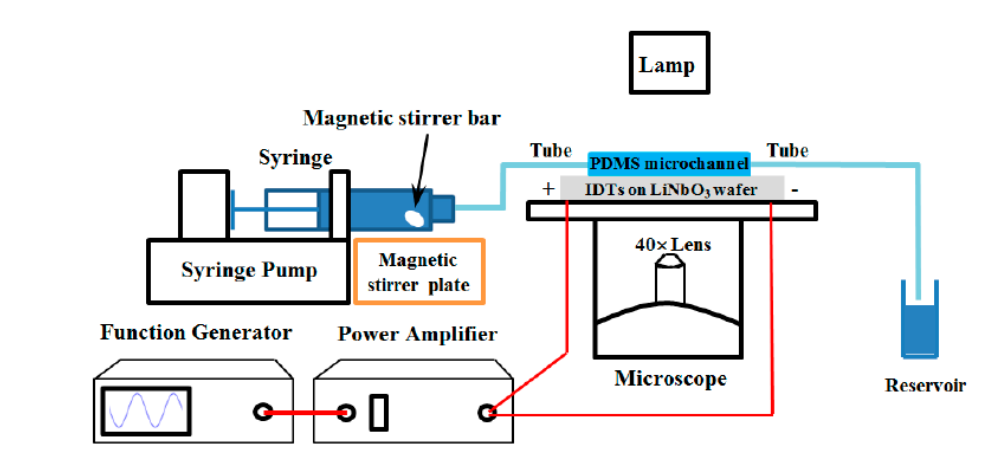Nanyang Technological University: Experimenting with Acoustic Nozzles to Disrupt Clogging in 3D Printing
 Thesis student, Yannapol Sriphutkiat, of the School of Mechanical and Aerospace Engineering at Nanyang Technological University recently published, ‘Development of acoustic nozzle for 3D printing,’ exploring the use of acoustic vibrations to solve one of the most common problems: clogging.
Thesis student, Yannapol Sriphutkiat, of the School of Mechanical and Aerospace Engineering at Nanyang Technological University recently published, ‘Development of acoustic nozzle for 3D printing,’ exploring the use of acoustic vibrations to solve one of the most common problems: clogging.
As with so many innovations and improvements allowed through 3D printing, it all makes perfect sense—using acoustics to manipulate microparticles and prevent clogging. For this study, Sriphutkiat researched the use of standing surface acoustic waves (SSAWs) in microchannels to reduce the issue.
Proper alignment of printing materials in the nozzle and elimination of clogging leads to a better outcome not only for 3D printing overall, but especially in bioprinting practices as it limits cell density in the material. While there are numerous challenges in bioprinting, clogging is one that still confounds and thwarts researchers:
“Suspensions are likely to sediment and aggregate in the cell reservoir, tube and nozzle of the printing system, the sedimentation reduces the width of the flow path which may also lead to clogging within the narrow geometry of the inkjet nozzle. The clogging could significantly increase the normal stress and shear stress applied to the cells, which may decrease the cell viability and proliferation rate, and decrease formation of nonuniform droplet sizes of bioink,” stated the researchers.
Although clogging continues to be a mystery in many ways, in this study, researchers are optimistic about the use of vibration as a solution for both stability in production and reduction of clogging too. The overall idea of such a technique is to ‘disturb the clogging behavior,’ which often seems to occur around the entrance of the pore throats, and then completely blocking or bridging the area.
“SSAWs move microparticles away from the wall, towards the center of the microchannel, and therefore, reduce the chance of microparticle accumulation/clogging,” stated the researchers, who employed dual-frequency excitation for the SSAWs, for better control.
The acoustic nozzle caused cells to accumulate toward the center of a cylindrical tube in the lab, allowing for success in 3D printing, with tuning of SSAWs decreasing the width of accumulated microparticles.
“In comparison to the conventional printing strategy, acoustic excitation could significantly reduce the width of accumulated microparticles in the printed structure (p < 0.05). In addition, the microparticle motion excited at higher harmonics (385 kHz and 657 kHz) was also studied,” stated the researchers.
The study continued successfully with bioprinting as the researchers observed C2C12 cells being controlled by the acoustics. Once printed, they were studied for a week. The cells exposed to acoustic excitation accumulated near the center of the nozzle, while cells from the control group were scattered. Acoustically manipulated cells also showed more ‘significant dense cell structure,’ while the control group cells were still more chaotic.
“Overall, the acoustic approach is able to accumulate microparticles/cells in the printed construct at a low cost, simple configuration, and low power, but high biocompatibility,” concluded the researchers. “In the future, acoustic patterning of various biological cell types in printed construct could be investigated. As acoustic method has a capability to manipulate the microparticle/biological cells depending on their physical properties (compressibility, density and size).
Sound has played a role in numerous 3D printing techniques, from the development of acoustic metamaterials to implanting items with sound data, or even 3D printed symphonies. Find out more about how innovations such as acoustic nozzles can improve the 3D printing process here. What do you think of this news? Let us know your thoughts! Join the discussion of this and other 3D printing topics at 3DPrintBoard.com.
[Source / Images: Development of acoustic nozzle for 3D printing]Subscribe to Our Email Newsletter
Stay up-to-date on all the latest news from the 3D printing industry and receive information and offers from third party vendors.
You May Also Like
3D Printing Unpeeled: Wind Turbines, Probiotics and Lenses
TPI Composites, ORNL and Ingersoll Rand are working to make wind turbine tooling segments that can be 18.3 meters long. These elements also include resistive wires that help keep the...
3D Printing Unpeeled: Digital FDM Filament for Functional Gradients
Just published in Nature, a paper by a Seoul National University team looks at “3D printing with a 3D printed digital material filament for programming functional gradients.” Sang-Joon Ahn, Howon...
3D Printing Unpeeled: $5000 Cold Spray 3D Printer, Roland DGA & Living Materials
The AeroForge is a $5000 cold spray metal printer for copper made by a student team at Rice University. In a paper for ACS Central Science a team from Nanjing...
3D Printing Webinar and Event Roundup: April 28, 2024
In this week’s 3D Printing Webinar and Event Roundup, the Ceramics Expo is taking place in Michigan, Stratasys continues its advanced training courses, and SPE is holding a Polymer Characterization...


































